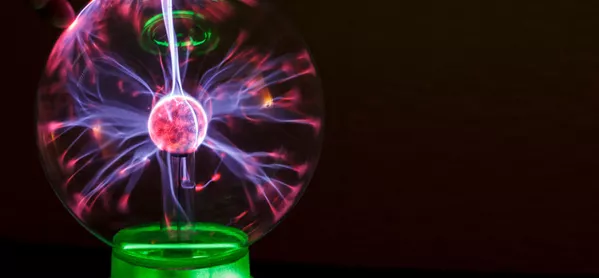How to spark your electricity lessons into life

I was working with some primary school pupils once and asked them, “What is your favourite science topic?” To my surprise, they said “electricity!” Ask the average Year 9 student the same question, however, and that would rarely be their answer - they would be more likely to say space, or topics on animals, or acids and alkalis with the good colours.
So why do primary pupils like learning about electricity so much, and is there a way to extend that enthusiasm all the way into secondary school?
I think part of the reason for primary pupils’ enjoyment is that the topic of electricity often allows them to do some practical work. In secondary school, most lessons involve experimenting with very well-equipped laboratories, but science resources tend to be scarcer for primary pupils. In secondary school, it’s hard for an electrical circuits kit to compete with a Bunsen burner!
As it is, the core syllabus for electricity in secondary school can be slightly dry, the experiments don’t tend to get significantly more exciting than they were in primary school, and the content becomes really rather difficult conceptually - thinking about the difference between current and voltage, for example.
Electric history
One way to tackle the topic, and to really capture pupils’ imagination, can be to consider the history of electricity. This is not usually part of the GCSE syllabus directly, but it can provide context and a starting point for what is.
As part of its schools programme, the Pod, EDF Energy has produced some fantastic resources to help consider sustainability in energy production, including a timeline on the history of electricity. Covering the period from 600BC, when mathematician Thales of Miletus discovered that polishing amber with wool created a static charge, to the modern day and questions around climate change and energy consumption, the timeline is a great source of inspiration.
The industrial revolution of 1780-1850 is an obvious place to start. You could begin by showing Danny Boyle’s incredible scene about this period of history from the opening ceremony of the London 2012 Olympics. You can discuss how advances during this time enabled the production of electricity on a big scale and the impact that had on people’s lives. In turn, this feeds into teaching about generators in the electromagnetism part of the GCSE syllabus.
James Watt’s steam engine was, of course, central to the industrial revolution and a key part of Boyle’s scene. Finding out more about the man behind the concept of horsepower, regardless of whether this knowledge will eventually be examined, might help pupils to remember the unit for power - and perhaps even the fact that it needs to be capitalised!
Battery power
You might also teach your students about Alessandro Volta’s invention of the first electric battery in 1799 (the “Voltaic pile”), to encourage them to think about what a supply of electricity really is and to define voltage. Herein lies another link to both a quantity and unit that pupils need to know. It could also link to their knowledge of chemistry as the Voltaic pile was a series of two electrodes - one made of zinc and another of copper.
Voltaic piles lead into the work of German physicist Georg Simon Ohm in the 1820s. Ohm experimented with the Voltaic piles and worked out the relationship between voltage and current, known as Ohm’s Law - a piece of knowledge that is commonly required in GCSE specifications, although teachers and students rarely question who it was that gave the unit its name. By putting a face to that name, however, students are more likely to retain the new terminology. Discussing the life and work of the French physicist André-Marie Ampère might also help pupils when it comes to learning about the principles of electromagnetism and the amp as a unit of current.
Plugging in
There are plenty of other advances, too, to use as examples to engage pupils’ interest. Take the electrical telegraph, which built on the work of Volta, Ampère and others to use electrical signals to send messages along wires. Initially, the telegraphs were used along the railways, but soon machines were being installed in post offices and, by the 1860s, the electrical telegraph was being used right across Europe and the United States. Whereas before messages were delivered by hand, often by riders on horseback who could be at risk of ambush or hampered by bad weather, suddenly messages could be sent safely, reliably and speedily across vast distances.
Even the humble plug has a dramatic story behind it. Try introducing AC and DC current in the context of the historic “war of currents” between Nikola Tesla and Thomas Edison in the 1880s, a commercial battle between two systems of lighting. The first plug socket, developed at around the same time, could also be used to explain the purpose of the different wires in a plug, and how that would have transformed life for people who had them installed - primarily by protecting them from electric shock!
Later in the timeline, the focus shifts to sustainability and alternative methods of producing electricity, such as nuclear, solar and wave power - key points in the GCSE syllabus. You could talk, for example, about the first nuclear power station to generate energy on an industrial scale, which opened in Calder Hall in Cumbria in 1956, or the world’s first commercial wave power plant, which operated for 18 years on the Scottish island of Islay.
Where next?
Finally, you could pose the question “what is coming next on this timeline?” Electric cars? Better batteries? Generation of electricity via nuclear fusion?
Engaging in the history - and future - of physics in lessons can be an effective way to bring a narrative to a topic; it is another way of linking a series of lessons. Perhaps, in doing so, it is also possible to engage a wider number of students, who may find it easier to follow a story than constantly build up from principles they have already found challenging.
Stephanie Grant is a physics teacher and assistant director of studies at Norwich School
